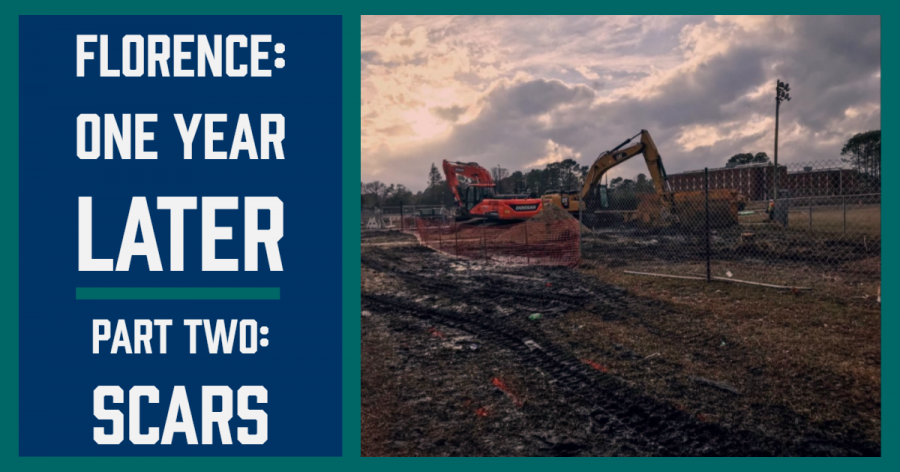Florence: one year later, scars
This article is part of a series about Hurricane Florence which hit Wilmington in 2018. This series will look back at how Florence impacted our community and look forward to see how it continues to affect us today
After being evacuated for nearly a month, students returned to UNC Wilmington to find that, while recovery was underway, the campus sustained significant damage. UNCW reported that 80 percent of the school’s 138 buildings had some form of damage, with 18 of those facing significant damage. Those 18 buildings included Dobo, Leutze, Cameron, Cornerstone, Galloway and all 13 University Apartments. Dobo Hall lost a portion of its roof and sustained about 35 inches of rainwater, while the University Apartments were eventually demolished because of black mold and extensive water damage.
Most minor repairs were made in the weeks immediately following Florence making landfall, but Dobo hall, which received the worst of the damage, was reported not to be open to the public until August 2020, with an estimated 60 million dollars in repairs required. “There was a need to move research material out of Dobo,” said Deb Tew, the Interim Director of Environmental Health and Safety in an interview with the University. “With standing water in the building, we had to turn off the generator because of the electricity, and so we had to get the freezers out… [We] were loading freezers in the back of trucks, and researchers were pushing freezers down the road to Friday Hall and Oriole Burevitch Laboratory.”
When the university started making repairs to the University Apartments, they found that there was no serious structural damage. It was quickly discovered that the water damage resulted in black mold; the damage was significantly worse than originally feared.
“There were all these people who were displaced who were gonna go back to their rooms, so some people were still hoping, because they never really confirmed that they were tearing down the apartments, that they were just going to completely give up,” Residence Assistant Matthew Prickett said in an interview. There was a significant amount of back and forth from the University as to whether or not students could move back into their housing. Ultimately, after much confusion, the decision was made that the apartments would be torn down. As the apartments were demolished, many residents were forced to move into hotels. “I lived in a hotel for two months following that,” Prickett said.
Drew Johnson was a Resident Assistant living in Cornerstone House at the time, and like many RAs on campus, he found just how widespread the damage to the buildings really was. “When the RAs finally did get to come back to campus to help reopen buildings, I then found out the extent of damage done to my building. Cornerstone has dry walls,” Johnson said, “…so the walls, especially on the first floor where I lived, had a lot of water damage. While my belongings were not damaged, I still had to wait a day before I got to move back into my space.”
In addition to all the damage to the buildings, Florence littered copious amounts of debris scattered across campus. There were an estimated 200 fallen trees on campus, which only further complicated repair efforts. Fortunately, campus was repaired enough to the point where it could be reopened in a little over a month. Even today, the scars from Florence can be seen across campus; not only in the buildings, but in the people themselves.









